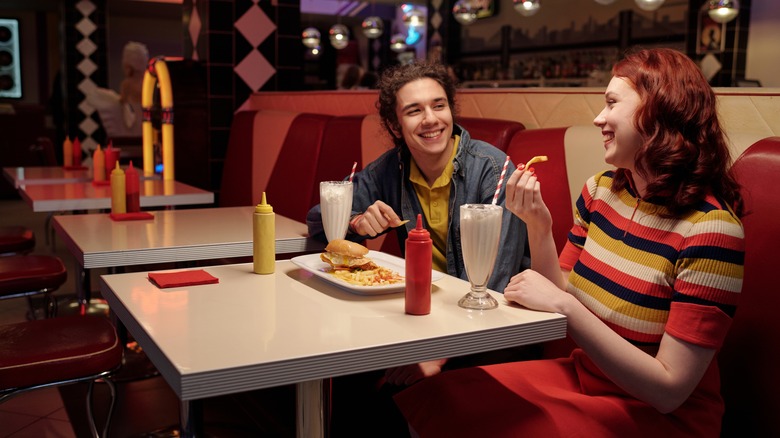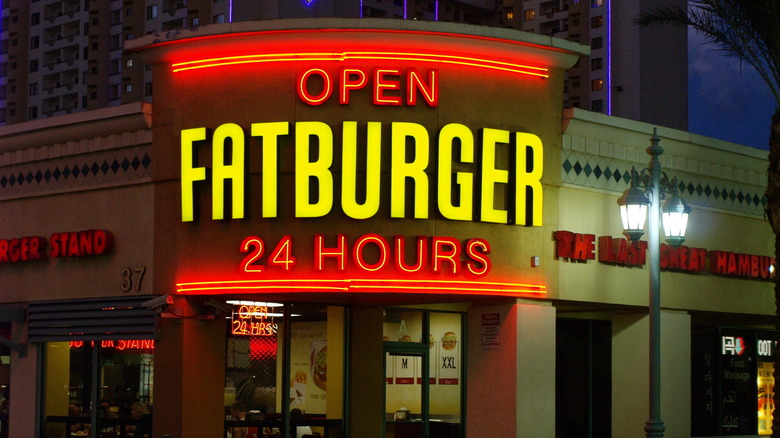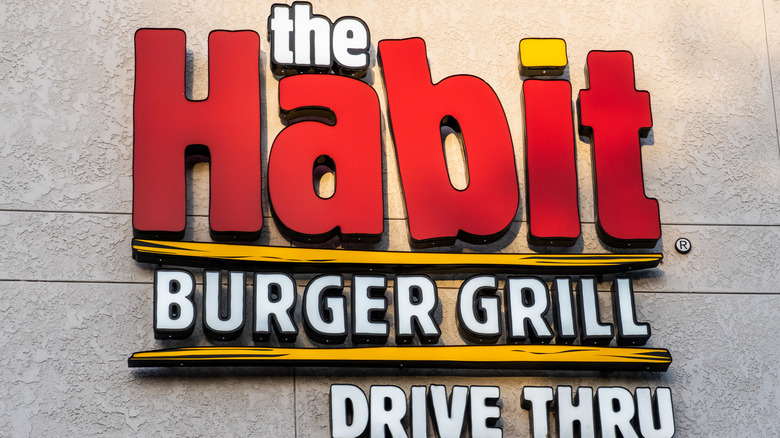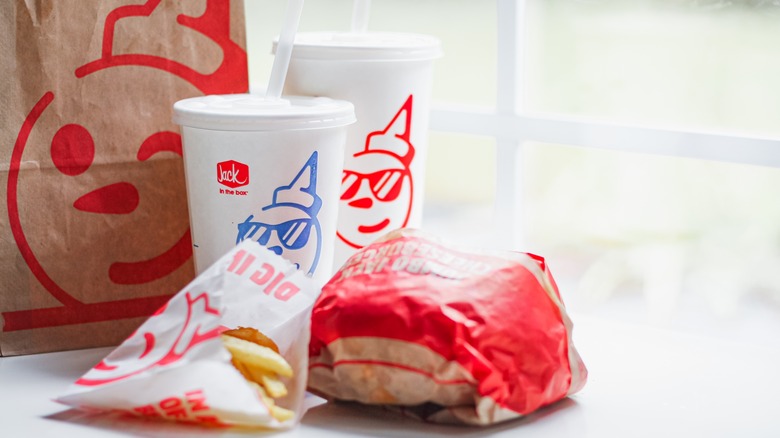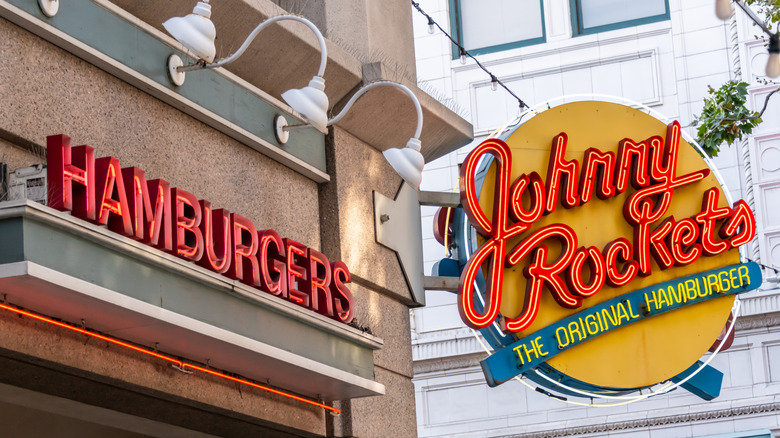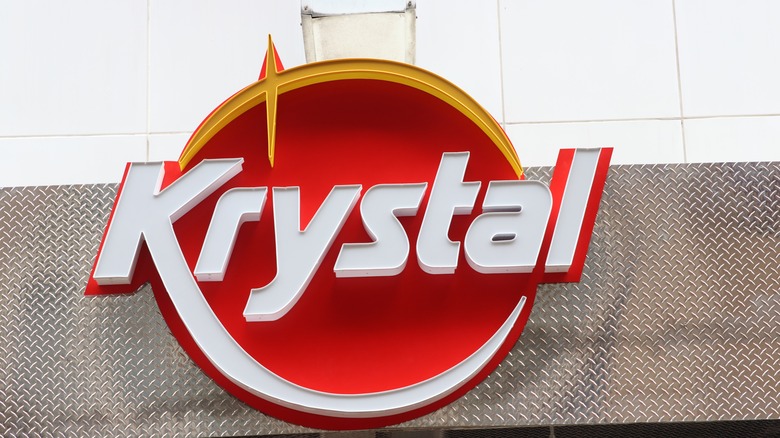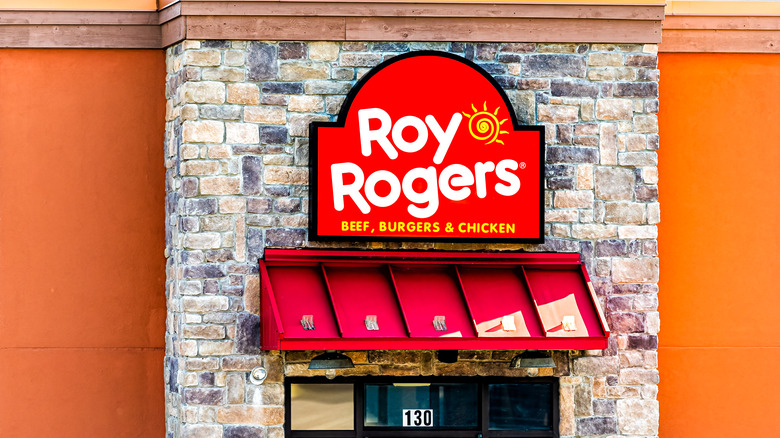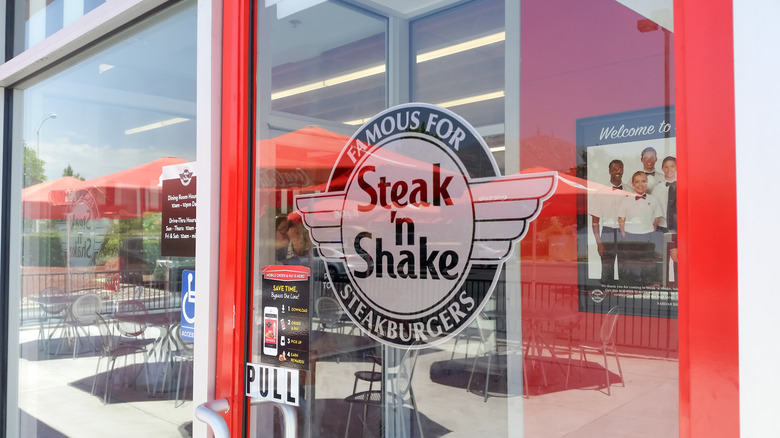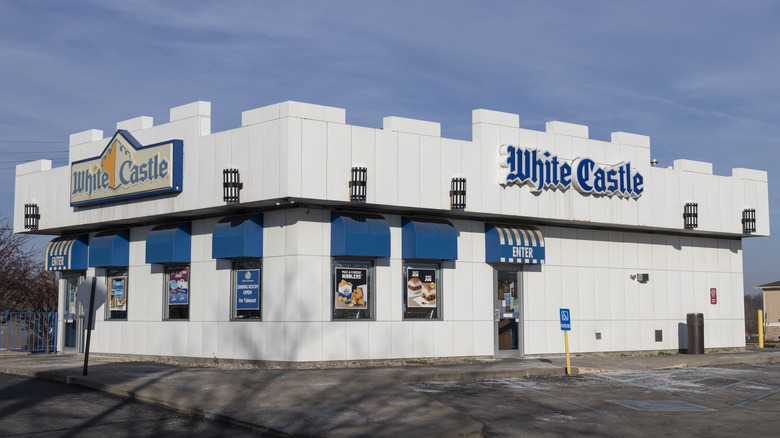10 Classic Burger Chains That Never Made It To Every US State
Widespread popularity isn't indicative of widespread reach, a point readily seen with many classic burger chains that have remained conservative in expanding across the country. While odds are a trip to a service station, a strip mall, or an outlet center in America will include a sighting — and maybe even a sampling — of one of the many nationwide burger chains, some brands continue to serve a more niche market even after decades in operation.
Whether a result of hard times or a desire opposed to outgrowing their business model, some classic chains like In-N-Out, Whataburger, and White Castle have built reputations that have further reach than their burgers. So while a Burger King, McDonald's, or Wendy's can be found in cities in every state — sometimes even doubles within blocks of one another — their classic competitors may take a little bit more planning to visit as they've yet to accommodate national fast foodies.
Fatburger
While many took the time following World War II to settle down and start families sparking a baby boom, Texas native Lovie Yancey found a different opportunity for growth. Partnering with construction worker Charles "Suitcase" Simpson — who benefited from labor and materials from his job to streamline the build — the pair established a walk-up burger stand with three stools in 1947 Los Angeles under the name Mr. Fatburger. As Fatburger was meant to evoke the size of the burgers, Yancey dropped the "Mr." along with her partner in 1952 before expansion took off.
Operating around the clock during an era when segregation remained widespread, Yancey herself frequently worked 18-hour days as she maintained high standards for the business that entertained celebrity clientele including James Brown, Ray Charles, and Redd Foxx. Branching out to locations nearer to Beverly Hills expanded the reach of high-profile guests to include the likes of Johnny Carson and Elizabeth Taylor. By 1990, Yancey sold company rights — save the original location — to investors before NBA Hall of Famer Magic Johnson's development group purchased the chain serving customers in 10 states in 2001. Before her death in 2008, Yancey sold the original location under the condition it never be torn down. Now, the first of "The Last Great Hamburger Stand" businesses can still be seen incorporated into housing on Western Avenue.
Habit Burger & Grill
The same year Neil Armstrong and Buzz Aldrin set foot on the moon and popular musical acts of the era gathered at what would come to be known as Woodstock, the first Hamburger Habit opened in Santa Barbara, California. Since then, the chain that now goes by Habit Burger & Grill has been working its way inward from either coast, expanding its reach to 14 different states. However, that growth didn't truly get underway until over four decades after the original launched in 1969.
After brothers Brent and Bruce Reichard purchased the first Habit in 1980, the chain offering charburgers had spread across California, Arizona, and Utah. While retaining locations across Santa Barbara, the brothers sold off the chain in 2007 to KarpReilly before franchising was offered in 2013 ahead of a 2014 public offering. Seven years later, after years of growth had included earning the title of best fast food burger, according to Consumer Reports, roughly 300 Habit restaurants fell under the ownership of Yum!, the parent company of KFC, Pizza Hut, and Taco Bell, as part of a $375 million deal.
In-N-Out
Considering the prominence of cars in the Los Angeles area, notorious for traffic, its undoubtedly difficult to picture a time when drive-thrus were non-existent in California. Yet that was exactly the case before Harry Snyder opened the first one when he launched In-N-Out Burger in 1948 alongside his wife, Esther. The same year, he revolutionized the industry when he introduced the two-way speaker box, paving the way for the standard in drive-thru service.
As cutting edge as Snyder's budding business was, accepting feedback from customers for the creation of popular menu items like the Double-Double and Animal-style burgers, the chain's menu has remained relatively unchanged. Similarly, progress has remained slow in growing beyond the Golden State as expansion beyond California hadn't kicked off until 1992 with a restaurant in Nevada. It was nearly another decade before a location opened in Arizona and eight years more to reach Utah. As of 2025, In-N-Out had shirked off some of its hesitance in branching away from the West Coast as it reached eight states with plans to spread to three more, including Tennessee where President Lynsi Snyder was relocating with her family as a regional office was expected to open in 2026.
Jack in the Box
A considerable number of fast food brands can trace their origins back to Southern California — even a failed attempt from filmmaker Steven Spielberg — and Jack in the Box is no different. In 1951, Robert O. Peterson opened the first location in San Diego nearly a decade before launching the parent company Foodmaker, Inc. to oversee the chain that had expanded to 180 locations throughout the Southwest. Growth of the business captured the attention of the Ralston Purina Company in 1968, kicking off even more expansion.
Stumbling blocks through the '80s and '90s found Jack in the Box temporarily abandoning its clown head logo and selling Foodmaker, Inc. only to reintroduce the world to Jack in 1994 after an E. coli outbreak had resulted in at least four deaths in 1993. By 2025, the brand that offered breakfast all day to customers in 21 states had branched into new marketing streams to promote its sandwiches, tacos, and egg rolls. This included appealing to podcast viewers with appearances on shows like "Hot Ones Versus" and having an ad read on the popular "Call Her Daddy" podcast.
Johnny Rockets
Though younger than some of the other listed burger chains, Johnny Rockets' embrace of the '50s diner experience certainly adds to its classic nature. In bold whites and reds, customers can sit at a booth, a table, or even saddle up to the lunch counter to enjoy a burger and fries with a hand-spun milkshake. Inspired by Johnny Appleseed and the Oldsmobile Rocket 88, founder Ronn Teitelbaum truly leaned into Americana when he opened the first location in Los Angeles after selling his men's clothing business to follow his dreams as a restauranteur.
Teitelbaum's launch was so successful that customers were still around at 5 a.m. the following morning. The popularity of the chain where diners could scroll through jukebox selections from their table with an occasional dance number from the staff found its reach expanding to amusement parks and stadiums as ownership changed. Passing from RedZone Capital Management, to Sun Capital Partners, and then to the Fatburger parent company FAT Brands in 2020, the nostalgia-laden chain had reached 24 states and Washington, D.C. on top of numerous international locations.
Krystal
The hardship of the Great Depression didn't mean entrepreneurship had been stifled — it just meant businesses had to get creative. So it was that co-founders Rody Davenport Jr. and J. Glenn Sherrill set about opening the first Krystal in Chattanooga, Tennessee. Keenly aware of the economic outlook, the chain began with a focus on turning out affordable menu options after Davenport got the seed of his idea from the Midwestern chain during a trip.
Initially offering only sliders and coffee, the burger brand put a focus on cleanliness until the lean years were over and the menu expanded with items like french fries and milkshakes. Success brought fandom, including from Elvis Presley who once ordered 100 sliders to hand out to a crowd that came to see him. But, it wasn't until 1990 that the business that started in a 250 square foot building opened up for franchise opportunities leading to growth throughout the South. In 2021, just under 90 years after originally opening, Krystal announced that it had sold over 10 billion sliders, a milestone reached despite only having locations in 11 states.
Roy Rogers
Before offering Roy Rogers, iconic entertainer and the King of the Cowboys, a licensing agreement, the burger chain first opened in 1967 under the name RoBee's Roast Beef House in Fort Wayne, Indiana. A trademark infringement lawsuit from Arby's forced Marriott's hand on the name as it acquired the business from Azar's Big Boy in 1968, but the logo design stayed. From then on, the chain grew in popularity across the Northeast as it debuted its Fixin's bar.
By 1990, Marriott opted to sell its control after more than 600 franchises had been opened, leading to the acquisition by Hardee's parent company Imasco for $365 million. The change of hands resulted in many locations being converted to Hardee's and locations continued to dwindle as they were sold off to competing chains. That shrinking trend persisted even after family franchisees Jim and Pete Plamandon Jr. decided to buy the brand in 2002. What followed was a period during which the concept was reset before new expansion could commence. Following the ups and downs, Roy Rogers locations can be found in five states.
Steak 'n Shake
Restaurant chain reach is often like a rollercoaster, as has been the case with Steak 'n Shake since it first opened in Normal, Illinois. Founded by Gus Belt in 1934, the pairing of steakburgers and milk shakes — worthy of an unforgettable list — only came after nixing an initial idea of a gas station that served beer and chicken. The popularity of the original location, where Belt would grind steaks in front of his customers, led to the purchase of the Goal Post restaurant chain that allowed counter service to shift to table service.
Following Belt's death in 1954, his wife continued operating the chain until 1969 as a number of purchases were set into motion leading to the 2008 control by Sardar Biglari. Under the Biglari Holdings company, Steak 'n Shake launched a prototype restaurant that echoed its roots, but a number of lawsuits led to the closure of more than 100 locations over a five-year span, shrinking the reach from more than 600 restaurants to less than 500. After once boasting a business in 30 states, downsizing left Steak 'n Shake operating in 23 states as it sought new ways to appeal to customers, including frying with beef tallow and accepting cryptocurrency as payment.
Whataburger
In 1950, Harmon Dobson launched a family-owned business that would remain so for decades while also growing to become the quintessential Texas burger chain. Keeping in line with the saying "everything's bigger in Texas," Dobson's chain opted for hefty burgers when the first location opened in Corpus Christi, a decision his limited pursuit of a journalism degree aided him in marketing through newspapers. As the business expanded and the orange and white colors cropped up all across the Lone Star State, Dobson perished in a plane crash in 1967 leaving his widow, known as Lady Grace, in charge.
Under her leadership, Whataburger opened its first drive-thru and introduced popular items like breakfast taquitos and the Whatachik'n sandwich. By 1993, son Tom Dobson took over the family business and led the chain beyond the borders of Texas. By the time Honey Butter Chicken Biscuits could be bought at more than 800 locations across 10 states, the majority ownership of Whataburger was sold to BDT Capital Partners in Chicago, Illinois. While Dobson remained on the board, customers can now enjoy the Texas original in 17 states while the vast majority of locations remain in Texas.
White Castle
Popular at cookouts, tailgates, and on appetizer menus, the slider's creation is often credited to the opening of White Castle dating all the way back to 1921. It was then that Billy Ingram launched his concept of sackfuls of small burgers in Wichita, Kansas. In addition to the unique burger style, White Castle is considered the first fast food burger chain while launching the concept of carryout meals. Enduring through the Great Depression and World War II — when ingenuity had produced quite a few old-school foods — the chain's creative nature found it offering fried eggs and hot dogs at a time where meat rationing impacted everyone.
Innovation also found White Castle obtaining a patent after Cincinnati, Ohio operator Earl Howell had started putting holes in the burgers to speed the cooking process. Also credited with being the first fast food chain to surpass a billion burgers sold, it should come as no surprise that the brand that inspired a movie franchise was also bestowed the title of most influential burger of all time by Time magazine in 2014, even as the sliders can only be found in 14 states.

